| |
| The Gracies |
Gracie Tree (1) (2) |
|
|
To compile the Gracie stories, I got a lot of assistance from others. Mum first of all, because her memory was so sharp, and from Richard Green, husband of a descendant of Ralph Herbert Gracie, my great uncle. Others have added bits of information relating to other branches of the large family. There were two variations on the story that needed to be resolved. One had my great grandfather being an Alexander Gracie and the other, a Ralph Gracie. Mum subscribed to the Alexander theory, but the weight of evidence supports Ralph. The apparent reason for having two versions is that the Ralph version has him convicted as a criminal in Scotland and transported. Ralph it seems, was a bit of a bad boy. Alexander on the other hand was a good boy, and this is why some people preferred him over Ralph as the ancestor. I've gone with Ralph, not just because he adds a bit of intrigue, but because as I stated above, the evidence supports it. Because Ralph also named his son Ralph I've referred to them in the early part of the story as Ralph Sr. & Ralph Jr. respectively, in an effort to avoid confusion. |
| |
If I may jump sideways for a moment.... There is, alas, no Gracie clan as such. Many smaller families aligned themselves with the larger, established clans, and the Gracies were no exception. These families / links were known as "septs", and the Gracies were tied to the Farquharson clan. The Farquharsons were loyal to the Stewarts, and were represented in a number of great battles, including Culloden. Gracies emigrated from Scotland, heading to various contries. Of course there were a lot who went to the United States, but Brazil of all places, was another destination. A Gracie from Scotland started the renowned Gracie martial arts dynasty in Brazil, and needless to say, there is a Ralph amongst them. |
| |
Ralph Snr. was born in Dumfriesshire, Scotland in 1787. Nothing is known of his early life or family. His occupation is recorded as a labourer and worker on steam engines. His wife Kirsty More, also recorded in a couple of places as Christina More, was born in Stirlingshire in 1796. It's probable that her registered name was Christina as this is the one used on some official records - e.g. death certificate, but perhaps she used Kirsty. She was a dairy maid and servant of all work. The dairy maid suggests that she may have had rural or farming origins. A convict description uncovered by my cousin Carole Parnell gives some insight into Kirsty's appearance. The dark complexion suggests that she worked outside, so this would fit. |
| |
Ralph Snr. and Kirsty had children, but just how many is uncertain - possibly three. Somewhere along the way, things went awry and on May 27, 1827, Ralph Sr. found himself in front of the magistrate in Glasgow for "uttering forged notes", and he was sentenced to transportation for life. The gaoler's report states that he was a member of a gang. In those days, the way the British got rid of undesirables was to send them to Australia. Under the circumstances, he could count himself lucky to be transported. Forgery was a capital offence at the time, following the introduction of an additional hundred plus offences that could see you sent you to the gallows. Of course you could be transported for the most trivial offence, and your reasons for committing the offence (e.g. stole a bit of bread because your children were starving) wasn't taken into account. Ralph Sr. may have been a bad guy and member of a criminal gang, or maybe just doing what he had to in order to survive. We will never know. Anyway, it wasn't Australia per se where Ralph Sr. was headed - it was Tasmania, then known as "Van Diemens Land". He set forth from London on the ship "Asia" on July 13, 1827, and arrived in Tasmania on November 30. The ship's master was John Edman and the surgeon Campbell France.
As for Kirsty, it appears she was roped in and sentenced at the same time to seven years (a standard term), but not transported until the following year. She may have been incarcerated on one of the "hulks" described below, whilst awaiting her transportation. On her record the name "More, Kirsty or Gracie" is used. She was accompanied on the ship "Harmony", departing from Downs on September 13, 1828 by Ralph Jr., whose age is shown variously as two years and four years. On her record she is shown as having two or three children, so one has to wonder if a couple were left in Scotland. In spite of her somewhat unfortunate circumstances, Kirsty did have some education and was able to read and write, as noted on her husband's record along with her religion - Protestant. They arrived in Tasmania on January 14, 1829. The ship's master was Bennett Ireland, and the surgeon William Clifford.
|
Convict records for both Ralph Sr. and Kirsty are a little difficult to read, as they are hand-written and not terribly legible. Some effort has been made by somebody to make them clearer, and I have cleaned up much of the background speckling. Ralph Sr. has the most comprehensive one, although it is the most difficult to read. Some parts do make very interesting reading however. He was connected with a gang. His behaviour was orderly on the hunks, and this needs some expanation. Prisons were over-crowded and in the harbours sat large numbers of old ships that were more or less rotting at anchor but deemed habitable by the likes of the "criminal class". Not surprisingly, somebody came up with the cunning idea of bunging loads of convicts onto these derelict ships. This lead to the "Hulks Act" in 1776. Convicts were often kept on these old ships for long periods - over a year sometimes, prior to transportation. They were not allowed on deck for exercise in sight of land so were kept below decks and didn't get a decent whiff of fresh air until they left. Diseases such as typhus took their toll. Ralph Sr. was initially imprisoned in Glasgow, but he clearly spent a short time in one of the hulks in London before shipping out. Anyway, he got to Tasmania in one piece and shortly after was made a special constable! He had a wee bit of bother all the same and his record shows him being found in the pub when in charge of two female convicts who were somewhat sloshed. What his wife thought of this is not recorded, but we can assume that she wouldn't have been impressed. He copped a fine for his dereliction of duty, but other notes that might show further skulduggery are too hard to read. Another record however shows him being dismissed from the police in September 1834, so we can presume he made further....shall we say, errors of judgement.
Kirsty was assigned to a Mr G. Robinson in 1852 and received her Ticket of Leave later that year. Records show that she got a reprimand in 1854 for being drunk.
Ralph Sr. received a conditional pardon in 1841 and settled down to life as a free man in Richmond. He did not live long to enjoy this, and died in June 1844. Kirsty lived another 30 years, dying in December 1874, aged 84. She remarried to a William Leper* on 24 January 1855. Her death certificate shows her as being the widow of a constable, which suggests that William too was a constable. Whether they had more children is not known at this time, but it doesn't look likely given that she was aged around 59. The 1842 census shows Ralph Sr. living in Richmond with a married female aged between 45 and 60 who had arrived as a convict (Kirsty) and a single male aged between 14 and 21 who had arrived free (Ralph Jr.). A brief summary of this can be viewed here. A more comprehensive record is also available for Ralph Sr.
* Another record suggests that Kirsty applied to marry William Leper, but he married a Margaret Kenna on 24 January 1855. This needs more research. (Extract from "Notorious Strumpets and Dangerous Girls" by Phillip Tardif).
|
| |
A copy of the record for children of convicts shows Ralph Jr. aged two, along with other kids who were sent out to Tasmania with their mothers. It can be seen that whilst some of the kids were on their own, others had siblings with them. Altogether, between 1787 and 1868, some 160,000 men, women and children were shipped out of Britain and sent to Australia. |
| |
Out of interest, some information on the hulks and transportation, including convict accounts can be found here. Another good source of information on specific hulks is found here. More little snippets that may be of interest are a convict shirt, and the type of lantern and handcuffs issed to police constables in Tasmania at the time Ralph Sr. was working in this capacity. He may have used one such lantern to find his way home after being nabbed in the pub with those female convicts. |
| |
Ralph Jr., hereafter referred to simply as Ralph, grew up in Tasmania and learnt a trade as a shipwright (ship builder). On February 1, 1851 at St Andrews Presbyterian Church in Hobart, he married Margaret Allwood, daughter of John Allwood, a farmer, & Janet McKinley. Janet was from Glasgow but it's not know where John came from. People didn't usually go to Tasmania on a voluntary basis so one or other was probably either transported or connected with the system in some way. In June that year, Ralph and Margaret set sail for NZ. They arrived in Auckland to find things fairly quiet, with a lot of people having left to prospect for gold. The story of Ralph's life in NZ was quite well documented when articles ran in the Waiuku Times and the Franklin Times on August 12, 1921 following his death. Both articles were similar, and both had him emigrating to Tasmania as a boy (the descendant-friendly version of events). Also, both quoted him being a settler for 72 years, a little longer than he actually was. The two articles were included with information provided by Richard Green. Some small parts are at odds with compelling evidence so where this occurs, the incorrect parts are shown in red. Regrettably, the photo mentioned seems to have disappeared. |
A VERY OLD COLONIST - DEATH OF MR RALPH GRACIE. AT AGE OF NINETY-EIGHT YEARS. Interesting Biographical Sketch.
One of the old pioneers who helped in the moulding of the Dominion and who braved the stress and storm of its early struggles has passed away in the person of Mr Ralph Gracie, of Waiuku, at the age of 98 years. For 72 years he has been a colonist and his long life has been one of interest and usefulness.
Born in Edinburgh in 1823, Mr Gracie emigrated when a boy to Tasmania, and few years later came to New Zealand. A shipwright by trade, he followed his occupation for many years. He built the first church at Te Awamutu, and the old mission station in that township. After two years residence at Te Awamutu he moved to Waiuku and took up a 10-acre property adjoining Colonel Hautain’s property, and known as Inglewood Forest Farm. Mr Gracie was all through the Maori War, having charge of the Government stores and acting as guide to the soldiers. The first cheese factory and public hall, and the first two churches at Waiuku were built by him.
Mr Gracie married the youngest daughter of Mr Murdoch McKinlay, of Edinburgh. Of a family of nine, five sons and four daughters, seven are still living. His grandchildren number 39, while there are over 30 great grand children. Mrs Gracie predeceased her husband 20 years ago. Mr Gracie resided at Waiuku until 11 months ago, when owing to advancing years he moved to town to reside with his son. He retained his faculties right to the last being able to read without the aid of glasses.
So now, after lifes fitful fever, he sleeps well, regretted and respected by all who knew him. His life stands as a record of the history of the district and he nobly played his part.
A few months ago representative of the Times interviewed the late Mr Gracie and wrote up the following sketch, which contains many interesting paragraphs. We publish that article below, together with a photograph of this remarkable old colonist taken at that time.
As the publication of the history and experiences of our old identities is without a doubt going to be a matter of considerable interest, and likely to be the means of many unrecorded incidents worthy of mention, I therefore have taken upon myself to interview one of Waiuku’s oldest pioneers, and whose narrative, I think is worthy of publication.
Mr Gracie, whose age is now 98, has a wonderful memory of its past. He walks into Waiuku two or three times a week for the mail and provisions, the return journey being about four miles. He lives by himself at "Pura Pura" where he first settled down in 1855, and nothing could induce him to leave the old spot until carried away.
Mr Gracie says: We arrived in Auckland in June 1851, by a little trading vessel called the Isabella from Tasmania. I was married only four months before arrival. When we got to Auckland we found the place practically deserted, as the people had been attracted away by the Californian gold diggings. I and another arranged with the Governor (Sir George Gray) to go to the Waikato to erect four flour mills, the first being erected at Maungatawhiri and continued at that occupation for over three years. And during that time Bishop Selwyn gave me a written proposition to go and reside on Morgan’s Mission Station "Otawhao" and erect buildings. This block of land was handed over to the Bishop to administer for the natives. The Bishop used to come through over-land from Wellington, and walked the distance. The scheme was not a success, and just at that time New Zealand altered its constitution.
When a Crown Colony the Mission was allowed 7000 pounds for native purposes, Mr Ewington and Mr Upton being two of the trustees on behalf of Bishop Selwyn, and owing to circumstances all work was stopped. This place is now Te Awamutu and great trouble was experienced in getting stores there, goods having to be left on the bank of the river and gathered from there.
On account of my wife I decided to give up this work and get nearer civilisation, as Waiuku then had great prospects, with a very large amount of trade going through there to the Waikato heads. As a large number of speculators were purchasing land at "Pura Pura", at the first land sale I bought a piece and settled down and have resided there ever since, except of course, when away working.
MAORI WAR
I remember in 1860 the war broke out in Taranaki, and fighting continued about 18 months, Governor Browne being removed and Sir George Grey being recalled to establish peace. The dispute being over a block of land, it was referred to the Home Government, who disapproved of Governor Browne’s work, and ordered the land be handed over to the natives again.
In 1863 I was in the Governments employ and went right through the war being employed in ship and boat building. At that time the difficulty was to follow and keep up the supply of stores owing to no suitable boats being available.
The Korahai was the first gunboat launched and I helped to build this boat from the start and went up the river in the first trip. When we got to Ngawhai a little steamer called the Avon we found had got snagged and sunk and I with the assistance of a gang of bluejackets and soldiers, got her up again. When repaired she started running aging carrying stores.
About the second trip, I still being on board the Korahai, there being four bluejackets and an officer named Eston, from the Commodore’s flagship Cornea, in charge. When going up the second trip the place was swarming with natives, but the instructions were not to interfere with any natives unless the natives attacked them.
AN UNLUCKY SHOT.
Going along to the left side we saw a party of natives armed and standing near the bank looking at us, and whatever induced the officer in charge to do so I cannot imaging; but Eston fired a shot at the natives. The natives told the bluejackets what foolish thing it was to do, and that we should know more about that shot when we came back; and sure enough this proved correct. When at Ngawhaia we picked up two more young officers, and after loading our stores started again for the Waikato Heads, the other two young fellows going with us, one being named Mitchell, a Lieutenant. When nearing the same place a number of natives could be seen waiting there, some trying to hide themselves, which I knew to be a bad sign. Eston the officer in charge was on the bridge, and with him were Lieutenant Mitchell and the other young fellow, their attention being drawn to the natives hiding on the bank.
Lieutenant Mitchell turned round to look, and as he did so an accurate shot from a native’s rifle struck him fairly in the breast and killed him. These young fellows knew nothing of the shooting incident upon the up trip. I was the only civilian on board, and it was mentioned on board that nothing was to said about the shooting at the natives, as it would mean a court martial. The body was taken back to Ngawhai for burial.
We still continued carrying stores up the river until after the last stand taken by the natives. That was the Orakau fight. Then they broke away in small parties.
I continued in the Government employ as long as the war lasted in the Waikato, and then left their employ about the end of 1865, and came home to my family and started my own calling, carpentry and building.
On the 11 June, 1901, when Waiuku was almost deserted, the people being away in Auckland witnessing the visit of Royalty, I lost my wife, suddenly, and not a soul near beyond myself.
I noticed by the papers some little time ago that our late Governor (Lord Liverpool) mentioned incidents of the war gathered from his father, amongst which appeared a word about the shooting incident upon the Waikato, which I have spoken about, and I believe the actual facts were never made known.
(There could be some discrepancies in the interview referred to above, as Ralph Gracie’s Certificate of Death shows that he was born in Dumfriesshire Scotland, and that he married Margaret Allwood who was born in Glasgow, the daughter of John and Janet (nee McKinley). They were married in Hobart, Tasmania, aged 27 and 18 respectively, according to the Certificates) |
| |
From the WAIUKU TIMES August 12th 1921. Obituary --- THE LATE RALPH GRACIE.
Mr Gracie, a very old resident of Waiuku, died on Tuesday at the residence of his daughter, Mrs Haig, Grove Road Edendale. Mr Gracie was a native of Edinburgh, being born there in the year 1823, nearly 98 years ago. When a boy he emigrated to Tasmania and after a few years came on to New Zealand, being a resident of 72 years standing. Mr Gracie was a shipwright by trade and built some of the boats used in the Maori war, as gunboats on the Waikato River. He also built the first church at Te Awamutu and the mission buildings in that town. Eventually he moved to Waiuku and took up a ten acre farm, adjoining the late Colonel Haultain’s farm. Mr Gracie was all through the Maori War, having charge of Government stores and acting as a guide for soldiers. It was related by him that he stood beside the late Lieut. Foljambe (father of Lord Liverpool, ex-Governor of N.Z.), on one occasion, and a young private was sniped off at their side. This occurred near the Waipa river. Mr Gracie built the present Kariotahi school, the first cheese factory, and first two churches and public hall in Waiuku. His wife predeceased him by about 20 years. He is survived by seven children, 2 having died, grandchildren numbering 39 and over 30 great grandchildren. Mr Gracie retained his faculties right to the end, and was able to read without the aid of glasses. Truly he was a grand old specimen of one of the earliest founders of this Dominion. His remains were laid to rest in the Waiuku Cemetery yesterday, the Rev Fussell officiating at the graveside and gave a brief address in which he referred to the long life of the deceased and the sure foundation which the oldest generation of settlers had laid for others to build on. (The inscriptions on the tombstone in the Waiuku Cemetery read as follows: In Loving memory of Margaret the beloved wife of Ralph Gracie, died June 11th 1901, aged 68 Years. Ralph Gracie Aged 98 Years. Till the day dawn and shadows flee away.) |
|
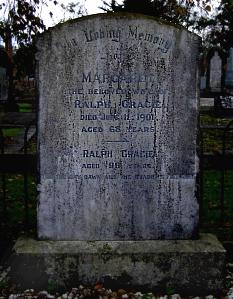
Ralph & Margaret's grave is said in some reports to be the oldest in Waiuku Cemetery. It is not.
|
Anyway, I've jumped ahead here. Ralph and Margaret had a large family, comprising five boys and four girls. Details of this generation can be seen on the tree here. Their youngest child, Arthur Moore Gracie, married Mary Jane Crooks (sometimes referred to as Minnie Mary) on August 17, 1905 at the house of Mary Jane's parents. Because this exercise is now more specific to my own branch, the second tree covers descendants of Arthur Moore Gracie, who was my grandfather. Mary Jane of course, was my Nana. I was not quite three when Nana died, but I have some vague memory of her. |
| |
Arthur's occupation is shown variously as a labourer, waterside worker, boiler engineer and bushman. Mum was pretty circumspect about the family, but as the stories have evolved, it seems that the old boy was rather fond of the amber fluid, and would often come home from work by way of the pub, and the six o'clock swill as it was called. (Pubs closed at 6:00pm and men would go straight from work and drink as much as they could before closing time, then stagger home). Recollections from older cousins who spent time at Stanley Road suggest that when Arthur arrived home, Nana and the girls would rush about seeing to his every need, and I ended up with the impression that they may have been frightened of him.
He wasn't the only one with a taste for beer, and at least a couple of the boys had an unhealthy relationship with the bottle. It also seems that the Gracie boys might have been larrikins. One story that could be attributed to Aunty Margie in her contribution to a historical book on the North Shore has them sitting on the bank drinking beer and giving cheek to people going to church. Sounds about right. There is a photo of my cousin David as a baby posed sitting on the bank with a beer bottle. Unfortunately, only one small photo of Arthur survived Aunty Kath's bonfire, and not much is known about him. He did serve in the army in the Boer War, and he re-enlisted in January 1916 for WW1, but did not pass the medical due to sciatica and was dischaged. Mum spoke about a large framed photo of him in his Boer War uniform, but it is believed to have gone on the bonfire. One might wonder why quite a few photos of Nana survived but only the single small one of Arthur. Could it be that he was not much liked? Was Aunty Kath attempting to exorcise some demons or expunge all memories of him? Mum would never volunteer much about her father. Her way of dealing with any bad stuff was to bury it deep, so it does beg the question.
|
|
| |
| Arthur's war record is a little difficult to read, but some information can be gleaned from it. |
He is decribed as 5' 9" tall, weighing 10 stone, with brown hair, a dark / fresh complexion and variously blue or grey eyes. His Boer War service is shown as four years, although it is noted that the duration of his overseas service (South Africa) was around 15 months. He did not advance beyond the rank of private. He was discharged after the Boer War in 1901, but as noted above, he re-enlisted in January 1916, only to be discharged on medical grounds, so was lucky enough not to be sent overseas. |
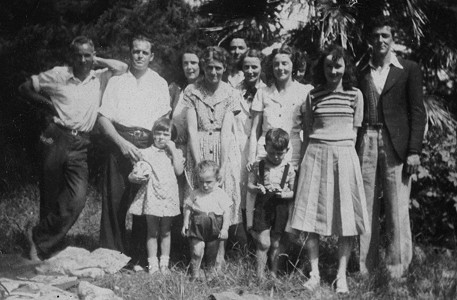 |
Most of the family got together for this photo taken at Stanley Road on Xmas Day 1939. This is one of the rare photos that was not taken sitting on the old tree stump that was a favourite spot, and significant in that it might have been the last time the group here would all be together. Adults from left to right are:
Len, Ray Morman, Eva, Jess, Spid, Dot Haig, Kathleen, Margie (obscured), Mum, Stan. Bunny was away sailing, so is not in the photo. In front are Beverly, David and Brian. Eva would have been around seven months pregnant with Alan, and in just four months time, Ray would be dead. Two years later, Spid would be killed in Egypt, and Len badly wounded in the same campaign at El Alamein. |
A number of Mum's siblings either did not marry, or had no family, and I wanted to preserve their memories so I have compiled short stories of their lives. As with other stories, I would love to hear from other family members or friends who have contributions from their own memories. |
| |
|
Aunty Margie |
Uncle Len |
Uncle Spid |
| Those who did marry can be summarised as follows: |
| |
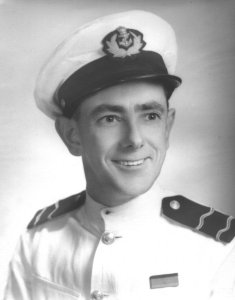
|
Stanley (Uncle Stan) was in the merchant marine during WW2 as a radio operator. He married Jessie Taylor and lived in the south Auckland area for a few years - Mt Wellington / Manurewa - before moving to Hamilton. They had four kids: David, Terence, Heather and Kevin, all of whom married and had families of their own. Aunty Jess's family were very religious and strict, and she had a tough life. Her mother was a Sunday School teacher but Aunty Jess herself didn't go for it.
Mum and I stayed with Uncle Stan and Aunty Jess at Heaphy Terrace in Hamilton a couple of times when I was a kid. They had a wood burning stove in the kitchen for water heating. Uncle Stan was building this big boat out back of the house. It was steel construction, a bit on the rusty side, and I remember him doing arc welding on it. He also had an old oxy-acetylene gas set of the vintage that had device for generating the acetylene gas with calcium carbide and water. Once when we stayed, I went out with to work with Kevin, who drove a truck delivering to grocery stores. He got me a meat pie for lunch in the company lunchroom, and one of his mates gave me a chocolate bar. A great day out!
For meals, we always started with soup, which tasted different to Mum's. There was always pudding as well, but it was served at the same time as the main, and I used to worry about it getting cold while I ate my dinner. I'll aways remember the carriage clock they had on the mantlepiece, and its chime every quarter hour. |
| |
Like his brothers, Uncle Stan was quite partial to a beer or three and regularly used to make home brew. One enduring memory is helping him with the bottling on one occasion. Tragedy seemed to stalk this line of the family, with a number dying well before their time. Aunty Jess was to outlive her husband, two of her sons and two of her grandchildren. After living alone for quite a few years, she moved to Kerikeri to be close to her daughter Heather and her family. |
| |
Eva (Aunty Eva) married Ray Morman, a plumber who played rugby league for a North Shore club, and a top bloke by all accounts. They had three kids: Beverley, Brian and Alan. Ray died suddenly in April 1940 when Alan was only two months old, leaving Eva to raise her young family on her own. She had another child Carole in 1953. The father was Arthur Hay, although he and Eva never married, nor lived together as a couple. Eva had previously known Arthur, either from her school days in Dargaville, or perhaps through Ray. In the early 1950s Brian just happened to be going out with Arthur's daughter Janette and they lived nearby. Arthur was a solo father, bringing up his three girls so there was a common bond. At the time, getting pregnant in these circumstances was a bit of a scandal and as such, the specifics were kept secret. Eva moved down to Waiuku and after Carole was born, she stayed with Mum and Dad for three months until I was born. In the past, Eva had fostered children from an organisation called "Motherhood of Man", so it was announced that she was fostering this little baby that she would soon decide out of the blue to "adopt". Mum was the only other one of her family who knew the truth, and with her watertight ability to keep her mouth shut, the terrible secret was safe! Perhaps plans were afoot for Arthur and Eva to get together, but we'll never know, because Arthur himself died suddenly in October 1954, apparently while fixing up a swing for Carole on Eva's back porch.
The rugby league tradition carried on when Bev married Neville Denton, who played on the wing for the Kiwis. Two of their three boys also played. Brian and Alan married and had two kids apiece while Carole married but did not have kids. For most of her life, Aunty Eva lived and worked in New Lynn, at Sonata Products. She moved to Australia in 1987 after becoming unwell, and died in 1995.
|
Ray's death was a real tragedy. He apparently had serious problem with his renal system that would have been very painful, although he seems to have kept this to himself - typical bloke. When Alan was born, Eva developed septicaemia and they were confined to hospital. Ray was visting Nana where the other kids were staying, and he just started getting very stressed, to the point where Granddad Gracie called for an doctor. Ray then did a runner, so when they caught up with him he was taken to the Avondale Mental Asylum in the belief he had gone crazy. Mum meanwhile had gone down the road to Dowse's because she was so upset. It was at Avondale that they discovered his real illness and he was sent to Auckland Hospital. By this stage it was well advanced, and he finally died of renal failure. His mother unfairly blamed Nana, telling her "God may forgive you but I never will". |
| |
|
|
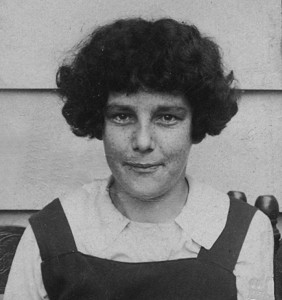
Young Eva. Looks like school uniform |
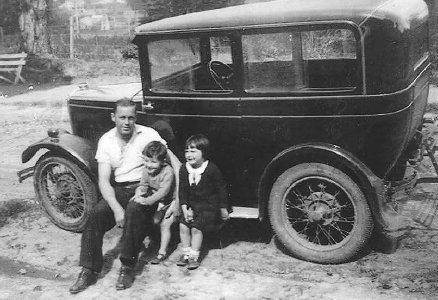
Ray Morman with Brian and Bev c1939. Cool car... |
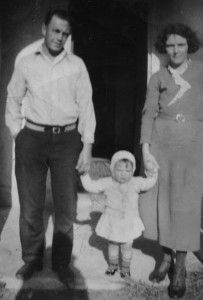
Ray, Bev & Eva 1936 |
| |
|
|
|
| |
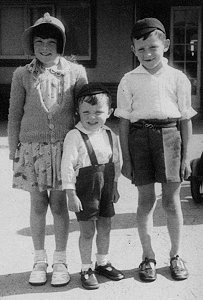 Bev, Alan & Brian Bev, Alan & Brian |
|
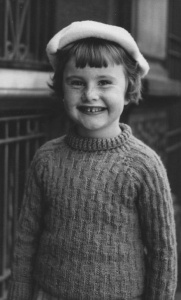
Then there was Carole |
| |
Harry (Uncle Bunny) was in the army during WW2 as a driver. He worked variously as a plumber, painter and hotel manager. Bunny married a little later in life to Leura Benfell, who had two daughters. At one point, Bunny & Leura managed the Waingaro Springs Hotel. Bunny always enjoyed a good laugh and was a bit of a joker. Leura was a dab hand on the piano. Like his younger brother Spid, Bunny was known pretty much only by his nickname. Why Bunny? I have no idea. |
|
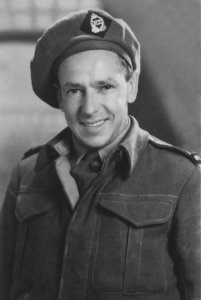 |
|
| |
| The youngest of the Gracie siblings was of course my mother. She has two stories - one in her words and another in mine. |
| |
|
|
| |
|